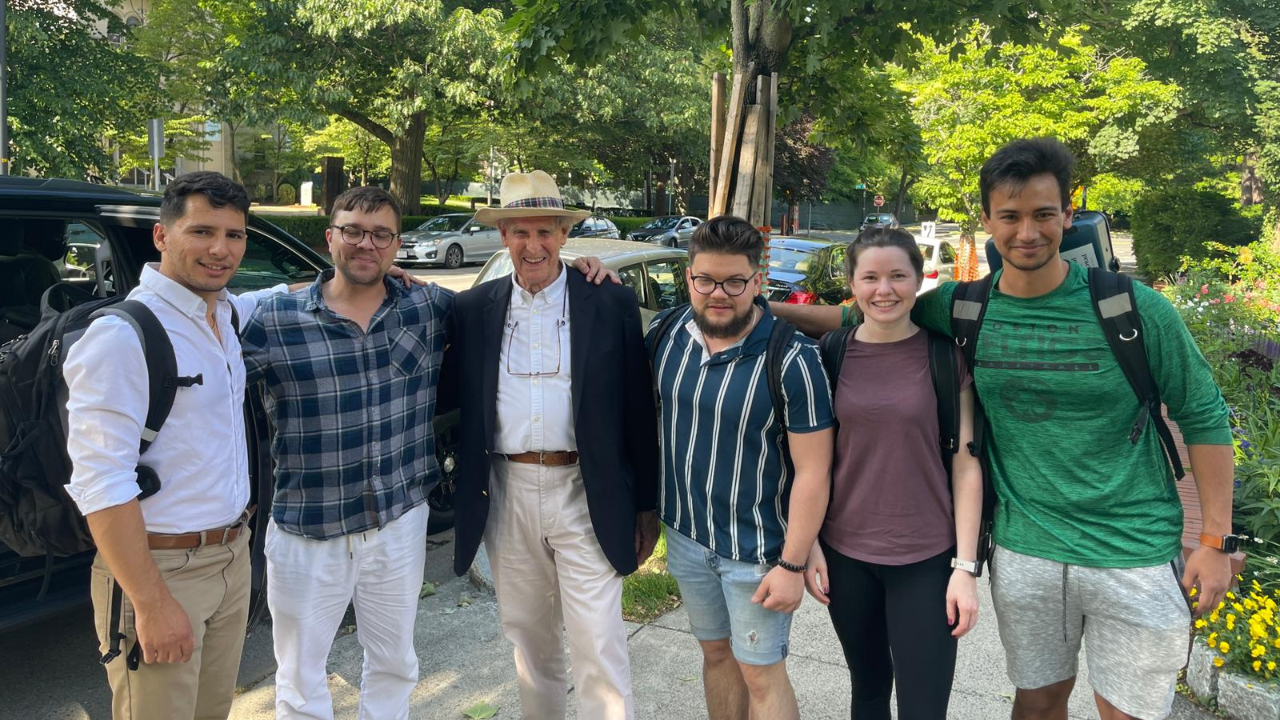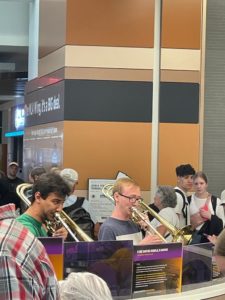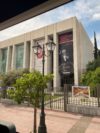BPYO 2022 Greece Tour - Day One

Well, it took nearly three years; involved countless hiccups, false starts, and unexpected twists; and comes while the coronavirus pandemic still rages, but the Boston Philharmonic Youth Orchestra is once again – at last! – on the road.
How things got to this point warrants, perhaps, its own book-length dissection. At present, at least, (and in my jet-lagged condition) such an undertaking is out of the question. Suffice it to say, the myriad financial and logistical details came together, and, last night, the orchestra embarked, via two airlines, for a two-week tour that traverses much of the Greek mainland and then some.

BPYO trombonists Lukas Helsel and Eli Canales giving an impromptu performance at Logan Airport’s Terminal E.
Fittingly, given the day and the many mentions of this sojourn being an “adventure,” this opening act certainly had the feel of one. For most of us, coming in to Logan on Sunday afternoon was a nightmare of construction and congested traffic. In Terminal E, check-in was a similarly dispiriting zoo (at least for the group flying on Delta – the other half of our number took Lufthansa): mobs of people, an understaffed airline, and a computer system that processed tickets with a measure of lethargy that would make a tortoise proud ensured bedlam. Beyond security, the situation wasn’t much improved, though the fact that the flights for both groups were delayed surely helped everybody make it through in time. Meanwhile, a coterie of brass players filled the extra time by serenading passengers in the gate area with an impromptu concert; despite incentive for the opposite, the general mood has been, shall we say, rather festive.
As for our menagerie, the numbers on this trip are impressive, especially given the times and circumstances: an ensemble of, roughly, 100 teenagers (mainly – there are a couple of younger and older BPYO members, as well as a few alumni and professional ringers along to cover for regulars who couldn’t make the tour), BPYO founder and music director Benjamin Zander, a bevy of chaperones, staff, and medical personnel – plus all the attendant baggage and instruments such a detail requires. In practice, I imagine that we look something like a small village on the move; as BPYO manager Elisabeth Christensen might agree, it certainly can feel that way.
Taken together, this is a slightly larger group than the one that travelled to Brazil on the BPYO’s last tour in 2019. However, this year’s itinerary is a touch lighter: there are just six concerts (down from nine in South America) and the trip lasts exactly fourteen days (as opposed to sixteen).
Otherwise, its two programs are similarly hard-core, these drawn from the orchestra’s 2021-22 season. They’re anchored by Dmitri Shostakovich’s epochal Fifth Symphony and Gustav Mahler’s transcendent Symphony No. 4. Cellist Zlatomir Fung is along, too, to play a pair of pieces, Piotr Tchaikovsky’s Variations on a Rococo Theme and Edward Elgar’s moving Cello Concerto. Also, soprano Sofia Fomina joins the group to reprise last November’s luminous account of the Mahler’s closing movement. Shostakovich’s Festive Overture and Maurice Ravel’s La Valse fill out the (printed) set list.

Banner announcing the BPYO’s performance on June 15th at the Megaron Athens Concert Hall.
Given the continuing pandemic and the availability of several Grecian amphitheaters, most of the tour’s performances are slated to be al fresco events; justWednesday’s opening concert here in Athens and Friday’s in Thessaloniki are indoors. Because it’s how things are done in these parts, the next couple of weeks promise to include some very late evenings: all the concerts start at 9 p.m. and are followed by dinner. I anticipate that, as in Brazil, many of our number will quickly become connoisseurs of the local coffee scene.
Regardless, this trip ought to be quite an experience. Perhaps the most welcome difference from the Brazil tour is that, though there are some side-by-side exchanges planned with a couple of local ensembles, there’s a good bit of time built into the schedule to simply breathe and take in Greece. And what a lineup of places we get to visit: Athens, Thessaloniki, Corfu, Ioannina, Delphi, Patras. Alas, no Crete or Santorini…but one mustn’t be greedy. (Also, something needs to be saved for next time.)
My goal in the following entries is to attempt to capture some of the flavor of being on the road in these places with the BPYO. That’s a tall order, as I learned three years ago in Brazil. On the one hand, just going by the numbers, it’s impossible to fully get to know this orchestra, even when we’re largely sequestered abroad with each other for a fortnight.
The difficulty is further compounded by the way the BPYO is made up and run. As anyone who’s read The Art of Possibility or a White Sheet in a program book (or gotten one of the same in an email) or attended last February’s performance of Shostakovich’s Fifth Symphony at Symphony Hall and heard Benjamin Zander read principal trumpet Cody York’s affecting meditation on the afternoon’s program knows, this is an orchestra comprised of individuals who, as a rule, aren’t just supremely talented young musicians. They’re that, for sure. But they also think deeply and seriously about what they do. They consider the music they play from all sorts of angles. They actively ponder their places and roles in the worlds they inhabit. And then they aim to connect everything back together.

The Acropolis at night, as viewed from the roof of Titania Hotel, where BPYO is staying.
To see and hear the strands converge is to experience one of the wonders of live musical performance: a hundred-plus viewpoints, thrillingly and seamlessly fused into one; reveling in the music; playing it with such conviction, wonder, excitement, and intentionality that, at its best, it doesn’t matter if you agree with the interpretive choices players and conductor have just made or not – or even if things sometimes aren’t quite technically flawless: you know that, ultimately, you’re in hands that aim to do much more than just dispatch the notes on the page. Often, as a result, you come away with a completely fresh understanding of music you thought you knew inside-out. That happened particularly memorably in this past season’s Mahler, Shostakovich, and, especially, Tchaikovsky symphony traversals. (How happy that two of those three are along on this tour!)
That said, doing justice to the complexity of what goes on within the BPYO – from the individuals to the alchemy of their collective achievement – can be quite the effort. Throw in the sights and sounds of Greece; the vagaries of what, exactly, occurs on the road; and the context of all that’s been lost, learned, regained, and newly appreciated thanks to the pandemic and, well…we’ll see what happens.
On the plus side, this looks like a pretty flexible group, one that ought to be able to take the unexpected well-enough in stride. Given the unique challenges of touring – a slightly different ensemble than the one that appeared at Symphony Hall all season long; dramatically different venues; intense repertoire packed into just a couple of weeks; whatever surprises general European travel in 2022 holds; along with the fact that, as we all know, the best-laid plans rarely unfold just as they should – that’s encouraging.
At present, though, we needn’t worry about those hypotheticals. The fundamental concern is far more pedestrian: a seven-hour time change needs to be conquered. Once that’s done, the City of Athena – and all else – awaits.
 Jonathan Blumhofer - Boston Classical Review
Jonathan Blumhofer - Boston Classical Review